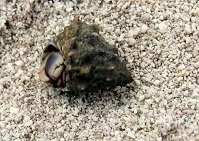Wildlife

Crab
The Bahamas has an odd wildlife system as the island nation has few indigenous mammals; only the raccoon, hutia, and bats are native, although goats, pigs, and other mammals have been brought by people. This simplicity is countered with the country's incredible sea life. As an island nation there are thousands of fish surrounding the country and the coral reefs surrounding the islands together create a larger coral system than the Great Barrier Reef in Australia. These waters contain larger animals like sharks and whales, but also include eels, angelfish, barracudas, grouper, sponges, lobsters, snapper, and thousands more.
Like the sea life, there are plenty of birds that live on the islands or migrate through. These birds are almost entirely limited to water fowls like ducks, flamingos, and heron, but there are other non-water fowl species that call the islands home such as the parrot. The reptilian and amphibian life is also limited in scope, but there are turtles, snakes, iguanas, and lizards of all kinds. There are numerous other species, including insects and spiders on the islands.